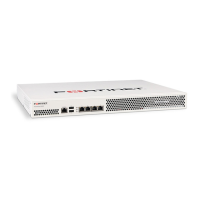Fortinet Technologies Inc. Page 17 FortiVoice 200D/200D-T v2.0 MR1 CLI Reference
Example of field commands
From within the admin_1 table, you might enter:
set passwd my1stExamplePassword
to assign the value my1stExamplePassword to the passwd field. You might then enter the
next command to save the changes and edit the next administrator’s table.
Permissions
Depending on the account that you use to log in to the FortiVoice unit, you may not have
complete access to all CLI commands or areas of the web-based manager.
Access profiles control which commands and areas an administrator account can access.
Access profiles assign either read, write, or no access to each area of the FortiVoice software.
To view configurations, you must have read access. To make changes, you must have write
access. For more information on configuring an access profile that administrator accounts can
use, see “system accprofile” on page 78.
Unlike other administrator accounts whose Access profile is super_admin_prof, the admin
administrator account exists by default and cannot be deleted. The admin administrator
account is similar to a root administrator account. This administrator account always has full
permission to view and change all FortiVoice configuration options, including viewing and
changing all other administrator accounts. It is the only administrator account that can reset
another administrator’s password without being required to enter the existing password. As
next Save the changes you have made in the current table’s fields,
and exit the edit command to the object prompt. (To save and
exit completely to the root prompt, use end instead.)
next is useful when you want to create or edit several tables in
the same object, without leaving and re-entering the config
command each time.
next is only available from a table prompt; it is not available
from an object prompt.
set
<field_nam
e> <value>
Set a field’s value.
For example, in config system admin, after typing edit
admin, you could type set passwd newpass to change the
password of the admin administrator to newpass.
Note: When using set to change a field containing a
space-delimited list, type the whole new list. For example, set
<field> <new-value> will replace the list with the
<new-value> rather than appending <new-value> to the list.
show Display changes to the default configuration. Changes are
listed in the form of configuration commands.
unset
<field_nam
e>
Reset the table or object’s fields to default values.
For example, in config system admin, after typing edit
admin, typing unset passwd resets the password of the
admin administrator account to the default (in this case, no
password).
Table 3: Commands for fields

